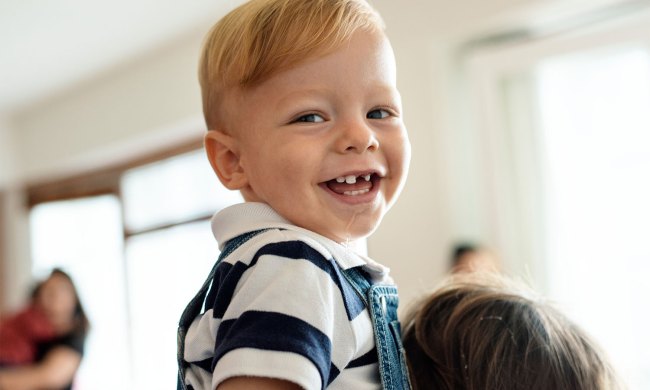Kids grow fast! And so do their needs for new toys that educate and entertain them. If you have a baby that is quickly turning into a toddler, odds are they are outgrowing their old toys and in need of some new ones. Kids in this age group aren’t quite toddlers, but they aren’t really into their baby toys anymore. Developing speech and language are essential at this age, so toys that promote this type of learning are excellent. Kids also begin developing a sense of adventure around this time as they gain mobility, so toys that safely encourage adventure are excellent choices as well. Weather permitting, outdoor toys allow your child to explore their broader environment and can help promote a healthy lifestyle. Ride-on toys are great in this respect and widen a child’s horizons while also developing their imagination. Check out some of our favorite toys for 18-24-month-olds below.
Diditrike

The Diditrike is a light-weight ride-on toy that is durable and features smooth wheels and a handlebar that is easy to maneuver. There are no pedals or batteries, so your little one gets to move at their own pace. The design offers support and stability, so your child won’t fall off while zooming around. The animal print design is fun for kids, and they can choose their favorite from either a zebra or a giraffe. The trike builds self-confidence and develops balance, spatial relations, and coordination in children. It also encourages active play. Little children may need some help getting on the trike at first, but once they are able, they will get on and ride off on their own.
Fisher-Price Bright Beats Dance & Move BeatBo

This brightly colored character provides kids with hours of fun by dancing and lighting up. Kids will love dancing and singing along with BeatBo during the three modes of fun – Dance n’ Move, Learning and Games, and Customized Sing-Along. Dance n’ Move features energizing music that encourages the child to move around. Learning and Games introduces ABC’s, colors, counting, and more to your child so they can learn while they play. The Customized Sing-Along feature allows you to record your own phrases or songs, and BeatBo will repeat it. This toy teaches cause and effect, encourages your baby to get moving, and teaches language basics all through song and dance.
Skip Hop Explore & More Jumpscape Fold-Away Jumper

This bouncer has a light-up bounce counter that track’s your baby’s jumps and rewards them with lights, music, and applause at 100-jump milestones. Featuring a 360-degree rotating seat, your baby can swivel all the way around, so they won’t miss any of the action around them. The clip-on toys are moveable and encourage development and imagination. The bouncer develops balance and stability while promoting a healthy lifestyle by working the leg and core muscles. The gadgets, lights, and buttons encourage color, shape, and pattern recognition. The bouncer folds up for storage when not in use.
Waddles the Waddle Duck

This push along toy is an adorable duck that quacks and flaps his feet as he waddles along with your child. The faster your kid pushes, the quicker the duck quacks. The toy promotes imaginative play while developing muscles. The toy is excellent for babies that are learning to walk as it offers something stable to hold onto while building the strength and stability to walk on their own. The “quack” noise will bring lots of laughs to you and your child, especially when it gets going really fast. This toy does not require batteries, which is nice since that means it can be played with continuously without the worry of it going silent.
Melissa & Doug Turtle Ball Pit

This ball pit is an adorable turtle that you will have a hard time getting your kids out of. The turtle is big enough to sit in and is designed to be climbed on. The ball pit comes with 60 balls that are soft plastic and two different sizes. The balls are six different colors and easy for little hands to grasp. All of the balls zip-up into the turtle when not in use for easy clean-up and storage. The multiple textures of the turtle ball pit nurture early childhood development physically, cognitively, and socially. There are holes to push and pull balls through, a non-slip bottom, crinkling feet, a squeaking button, a textured ring, a mirror, silky fabric tags, and an attached soft ball rattle, so kids are sure to be amused for hours on end.
Galt Tick Tock Clock

This friendly clock has handles that turn the hands around the clock, accompanied by a pleasing clicking sound and chiming bell. The clock’s eyes also roll around when the handles are turned. This toy helps you teach your child how to tell time and the value of time while promoting hand-eye coordination and teaching cause and effect. Number recognition is also learned through play with this clock. Use the clock to introduce children to specific times, such as bedtime, lunchtime, and more.
Everearth 7-in-1 Garden Activity Cube

The Garden Activity Cube offers endless hours of fun and learning for your children. The cube features bead mazes, a number tree maze, various sorting blocks, and more, all of which improve motor-skills. The activity cube is made of solid wood and painted with water-based, saliva-proof paint that is easy to clean. The toy encourages number recognition and counting, color recognition, shape recognition, is excellent for dexterity and hand-eye coordination and promotes problem-solving logic. Threading the balls through the wired mazes and spinning the different cogs also helps kids gain a sense of their movements and grasps, which leads to improved dexterity.
Freddie’s Activity Bus

This soft, colorful bus teaches your child to tie, snap, button, and zip, all while playing. Children will love pushing the bus along the floor while developing color, shape, and pattern recognition. The toy promotes imaginative play and develops fine motor skills. Parents will love using this toy as an aid to show kids how to handle the different actions that they will need to tie their shoes and dress themselves.



